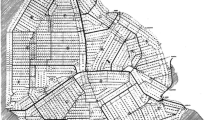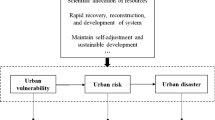Abstract
Sustainable evaluation of the eco-economic systems is crucial to resolve the contradiction between environmental protection and economic development and promote healthy urban development. This paper constructed an SEC framework for sustainable development index (SDI) evaluation of the eco-economic systems in the π-shaped Curve Area in the Yellow River basin based on the 3D ecological footprint (EF) model. The study was conducted from three aspects: the capital utilization scale and equity during the ecological supply and demand process, the development efficiency and capacity of the eco-economic systems, and the relations between the systems embodied by the coordination and security evaluation. Also, the SDI and its influence mechanism were studied using the fully arrayed polygon diagram and geographic detector. Findings include the following: EF depth is higher in cities with poor natural resources, while EF size is higher in cities with vast territories and rich resources. The arrangement of EF depth and EF size presents nearly a reverse trend, and the consumption of capital flow and capital stock complements each other. Cities can be classified as heavy utilization type, moderate utilization type, mild utilization type, and low stock appropriation type. From 2005 to 2019, the area’s SDI and the three aspects presented evident spatial heterogeneity and formed clusters. The role of government, energy consumption, scientific innovation, industrial structure, urbanization rate, population, economic level, and openness level impact SDI differently. This study proposed a new insight for the sustainability evaluation of eco-economic systems.










Similar content being viewed by others
Data availability
There is no data or materials associated with this submission.
Abbreviations
- EF:
-
Ecological footprint
- ef:
-
Ecological footprint per capita
- EC:
-
Ecological carrying capacity
- ec:
-
Ecological carrying capacity per capita
- EPI:
-
Ecological pressure index
- SCI:
-
System coordination index
- HDI:
-
Human development index
- ED:
-
Ecological deficit
- ed:
-
Ecological deficit per capita
- ES:
-
Ecological surplus
- es:
-
Ecological surplus per capita
- SDI:
-
Sustainable development index
- NCS:
-
Natural capital stock
- FPD:
-
Fully arrayed polygon diagram
- GDP:
-
Gross domestic product
References
Bi M, **e G, Yao C (2020) Improvement of human sustainable development index and international comparison (in Chinese). J Nat Resour 35:1017–1029
Chen J, Cheng S, Song M (2017) Decomposing inequality in energy-related CO2 emissions by source and source increment: the roles of production and residential consumption. Energy Policy 107:698–710
Costanza R, Daly H (1992) Natural capital and sustainable development. Conserv Biol 6:37–46
Daly HE (1994) Operationalizing sustainable development by investing in natural capital. Investing in natural capital 23–37
Druckman A, Jackson T (2008) Measuring resource inequalities: the concepts and methodology for an area-based Gini coefficient. Ecol Econ 65:242–252
Fang K, Heijungs R (2012) A review on three-dimensional ecological footprint model for natural capital accounting. Prog Geogr 31:1700–1707
Fang C, Zhou C, Gu C, Chen L, Li S (2017) A proposal for the theoretical analysis of the interactive coupled effects between urbanization and the eco-environment in mega-urban agglomerations. J Geog Sci 27:1431–1449
Fang K, Zhang Q, Yu H, Wang Y, Dong L, Shi L (2018) Sustainability of the use of natural capital in a city: measuring the size and depth of urban ecological and water footprints. Sci Total Environ 631–632:476–484
Feng R, Wang K, Wang F (2022) Quantifying influences of administrative division adjustment on PM2.5 pollution in China’s mega-urban agglomerations. J Environ Manag 302:113993
Gao H, ** J, Li F, Zhou C (2015) Evaluation and development strategy of provincial rural human settlement construction in China (in Chinese). J Ecol Rural Environ 31:835–843
Inner Mongolia Autonomous Region Bureau of Statistics (2005–2019) Inner Mongolia statistical yearbook 2005–2019a. China Statistics Press
Jiang X, Xu Z (1993) General theory of ecological economics. China Forestry Publishing House
Li Y, Wu H, Hu Y, Wang H, Yang B (2021) Analysis on the positioning of Baotou in the π-shaped Curve Area in the Yellow River basin (in Chinese). Northern Economy, 42–45
Long X, Yu H, Sun M, Wang X-C, Klemeš JJ, **e W, Wang C, Li W, Wang Y (2020) Sustainability evaluation based on the Three-dimensional Ecological Footprint and Human Development Index: a case study on the four island regions in China. J Environ Manage 265:110509
Lu J (2018) Evaluation on the status and function of national-level economic and technological development zones in Bei**g-Tian**-Hebei (in Chinese). Scientia Geographica Sinica 38:78–86
McGillivray M, White H (1993) Measuring development? The UNDP’s human development index. J Int Dev 5:183–192
Ministry of Housing and Urban-Rural Development (2005–2019) China urban construction statistical yearbook 2005–2019
National Bureau of Statistics (2005–2019) China City statistical yearbook 2005–2019b. China Statistics Press
National Forestry and Grassland Administration (2005–2019) China forestry and grassland statistical yearbook 2005–2019. China Forestry Publishing House
Niccolucci V, Galli A, Reed A, Neri E, Wackernagel M, Bastianoni S (2011) Towards a 3D national ecological footprint geography. Ecol Model 222:2939–2944
Ningxia Hui Autonomous Region Bureau of Statistics (2005–2019) Ningxia Statistical Yearbook. China Statistics Press
Pan S, Li B, Nie H (2020) Research on the path of China's sustainable economic development from the perspective of energy constraints (in Chinese). Inquiry into Economic Issues, 158–169
Pearce DW, Turner RK (1990) Economic of natural resources and the environment.
Peng J, Du Y, Ma J, Liu Z, Liu Y, Wei H (2015) Sustainability evaluation of natural capital utilization based on 3DEF model: A case study in Bei**g City, China. Ecol Ind 58:254–266
Peng F, Sun C, Liu T, Li Y, Hu W (2018) Temporal and spatial evolution of vulnerability and coordination of marine eco-economic system in coastal area of China (in Chinese). Economic Geography 38
Rees WE (1992) Ecological footprints and appropriated carrying capacity: what urban economics leaves out. Environ Urban 4:121–130
Shu H, **ong P (2018) The Gini coefficient structure and its application for the evaluation of regional balance development in China. J Clean Prod 199:668–686
Siegel PB, Johnson TG, Alwang J (1995) Regional economic diversity and diversification. Growth Chang 26:261–284
Shanxi Provincial Bureau of Statistics (2005–2019a) Shanxi Statistical yearbook 2005–2019. China Statistics Press
Shaanxi Provincial Bureau of Statistics (2005–2019b) Shaanxi statistical yearbook 2005–2019. China Statistics Press
Statistics Bureau of 17 Cities (2005–2019) Statistical Yearbook of Shizuishan, Wuzhong, Yinchuan, Zhongwei, Yulin, Yanan, Bayannaoer, Baotou, Hohhot, Ordos, Wuhai, Datong, Linfen, Taiyuan, **nzhou, Shuozhou, and Lvliang from 2005–2019
Sun Y, Wang N (2021b): Eco-efficiency in China’s Loess Plateau Region and its influencing factors: a data envelopment analysis from both static and dynamic perspectives. Environmental Science and Pollution Research
Sun Y, Wang N (2021a) Development and correlations of the industrial ecology in China’s Loess Plateau: a study based on the coupling coordination model and spatial network effect. Ecol Ind 132:108332
Sun Y, Wang N (2022) Sustainable urban development of the π-shaped Curve Area in the Yellow River basin under ecological constraints: a study based on the improved ecological footprint model. J Clean Prod 337:130452
Tang M, LIang C, Zeng J, Geng Y (2021): Development characteristics and transformation paths of towns in Fujian Triangle urban agglomeration under ecological constraints (in Chinese). Acta Ecologica Sinica, 1–13
Templet PH (1999) Energy, diversity and development in economic systems; an empirical analysis. Ecol Econ 30:223–233
Tilman D (1996) Biodiversity: population versus ecosystem stability. Ecology 77:350–363
Ulanowicz R (1986) Growth and development: ecosystems phenomenology, 11. Springer Verlag
UNDP China (2013a) China national human development report 2013a-Sustainable and liveable cities: toward ecological civilization
UNDP China (2013b) China human development report 2009/2010- China and a sustainable future: towards a low carbon economy and society
UNDP China (2013c) China human development report 2005
UNDP China (2013d) China human development report 2007/08-Access for all: basic public services for 1.3 billion people
UNDP China (2016) China National human development report 2016- Social innovation for inclusive human development
UNDP China (2019) China national human development report special edition-In pursuit of a more sustainable future for all: China’s historic transformation over four decades of human development
Wackernagel M, Rees W (1998) Our ecological footprint: reducing human impact on the earth Gabriola Island. NewSociety Publishers, B.C., Canada
Wang J, Xu C (2017) Geodetector: Principle and prospective. Acta Geogr Sin 72:116–134
Wang Z, Yang L, Yin J, Zhang B (2018) Assessment and prediction of environmental sustainability in China based on a modified ecological footprint model. Resour Conserv Recycl 132:301–313
Wu F, Yang X, Shen Z, Bian D, Babuna P (2021): Exploring sustainability and decoupling effects of natural capital utilization in China: evidence from a provincial three-dimensional ecological footprint. Journal of Cleaner Production, 126486
Xu Z, Zhang Z, Cheng G (2003): Theoretical methods and applications of ecological economics (in Chinese). Yellow River Water Conservancy Press
Yang Y, Cai Z (2020) Ecological security assessment of the Guanzhong Plain urban agglomeration based on an adapted ecological footprint model. J Clean Prod 260:120973
Yang Y, Fan M (2019) Analysis of spatial and temporal differences and equity of ecological footprints of provinces along the Silk Road Economic Belt in China. Acta Ecol Sin 39:5040–5050
Yang Y, Hu D (2018) Natural capital utilization based on a three-dimensional ecological footprint model: a case study in northern Shaanxi, China. Ecol Ind 87:178–188
Yang Y, Yang H, Cheng Y (2021) Why is it crucial to evaluate the fairness of natural capital consumption in urban agglomerations in terms of ecosystem services and economic contribution? Sustain Cities Soc 65:102644
Yang Y, Lu H, Liang D, Chen Y, Tian P, **a J (2020): Analysis and Ecological compensation of urban agglomeration in the middle reaches of the Yangtze River based on the three-dimensional ecological footprint model (in Chinese). Acta Ecologica Sinica, 1–12
Zhang Y (2020): New ideas for the analysis of eco-economic systems in resource-based cities. Industrial Innovation, 17–21
Zhao X, **ao L, Ma C, Wei L, Gao L (2006): Design of sustainability indicators system based on ecological footprint (in Chinese) . Scientia Agricultura Sinica, 1202–1207
Funding
This research was supported by the National Science Foundation of China (Grant No. 42130516)
Author information
Authors and Affiliations
Contributions
Yifang Sun: conceptualization, methodology, software, validation, formal analysis, investigation, data curation, writing—reviewing and editing, visualization.
Ninglian Wang: supervision, project administration, funding acquisition.
Corresponding author
Ethics declarations
Ethics approval
There is no data collected from human subjects.
Consent to publish
The work was original research that has not been published previously, and not under consideration for publication elsewhere, in whole or in part. All the authors listed have approved the publish.
Consent to participate
Not applicable.
Competing interests
The authors declare no competing interests.
Additional information
Responsible Editor: Marcus Schulz.
Publisher's note
Springer Nature remains neutral with regard to jurisdictional claims in published maps and institutional affiliations.
Highlights
• An “SEC” framework for evaluating the eco-economic system was proposed.
• The influence mechanism of sustainable eco-economy was explored using geodetector.
• The comprehensive sustainability was measured using the fully arrayed polygon diagram.
• Cities can be classified into four types based on their footprint size and footprint depth.
Supplementary Information
Below is the link to the electronic supplementary material.
Rights and permissions
About this article
Cite this article
Sun, Y., Wang, N. Sustainable evaluation of the eco-economic systems in the π-shaped Curve Area of the Yellow River basin of China: a study based on the 3D ecological footprint model. Environ Sci Pollut Res 29, 75921–75935 (2022). https://doi.org/10.1007/s11356-022-20948-x
Received:
Accepted:
Published:
Issue Date:
DOI: https://doi.org/10.1007/s11356-022-20948-x




